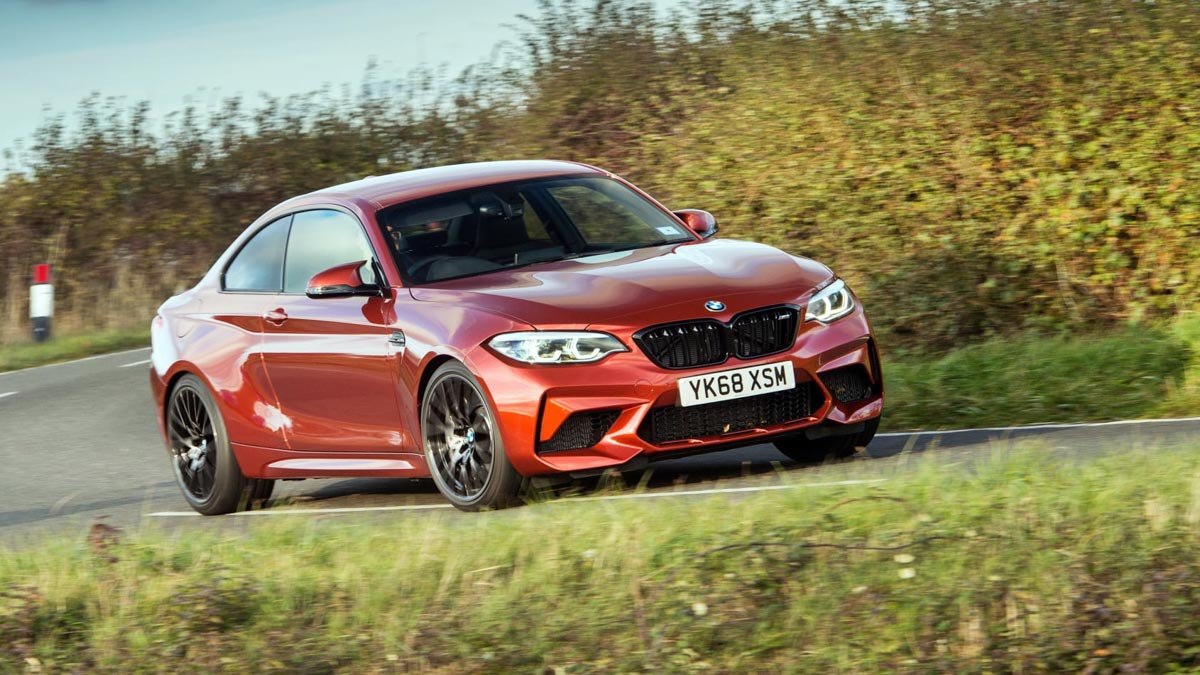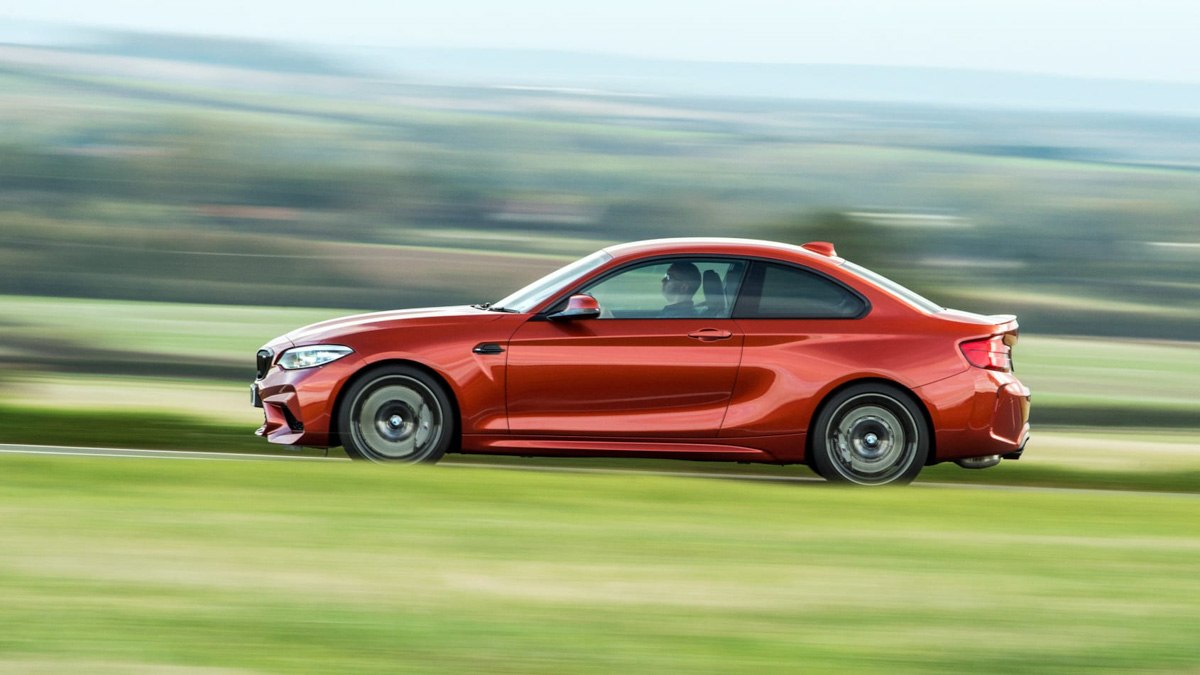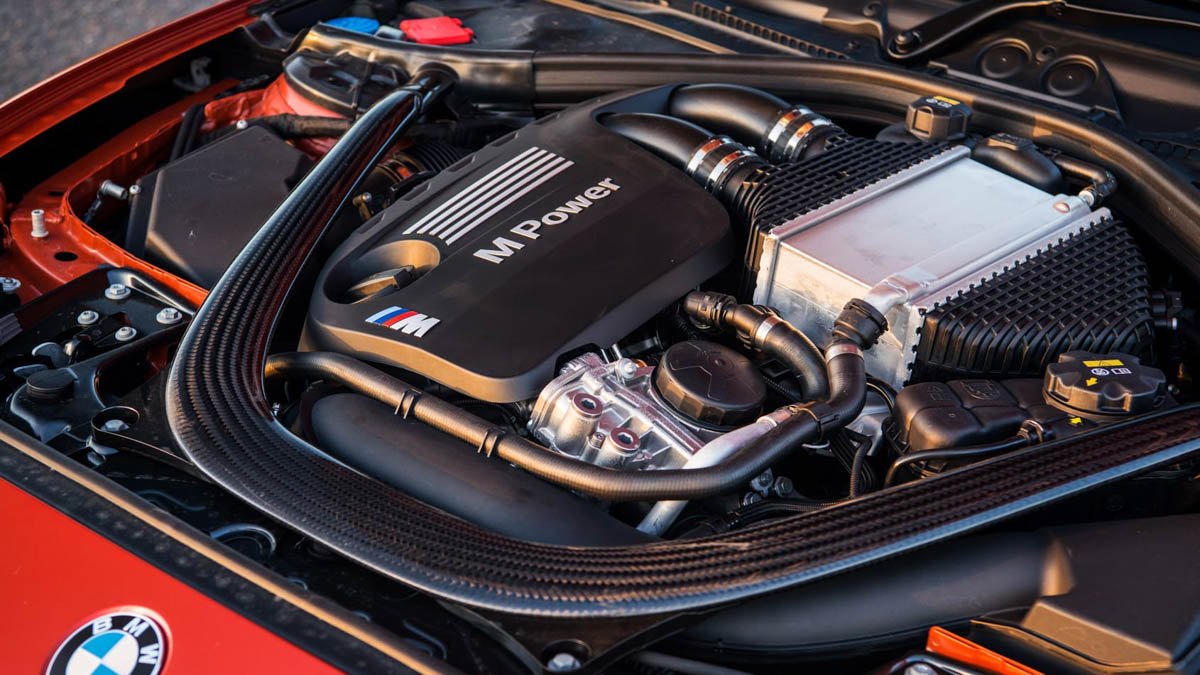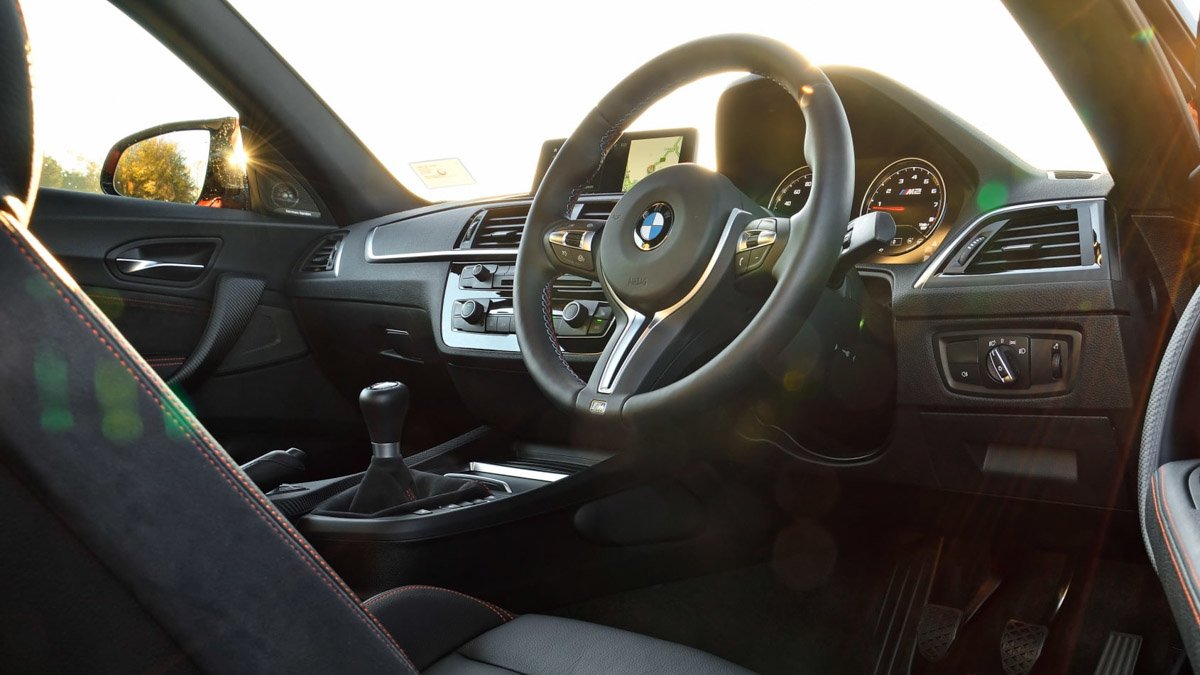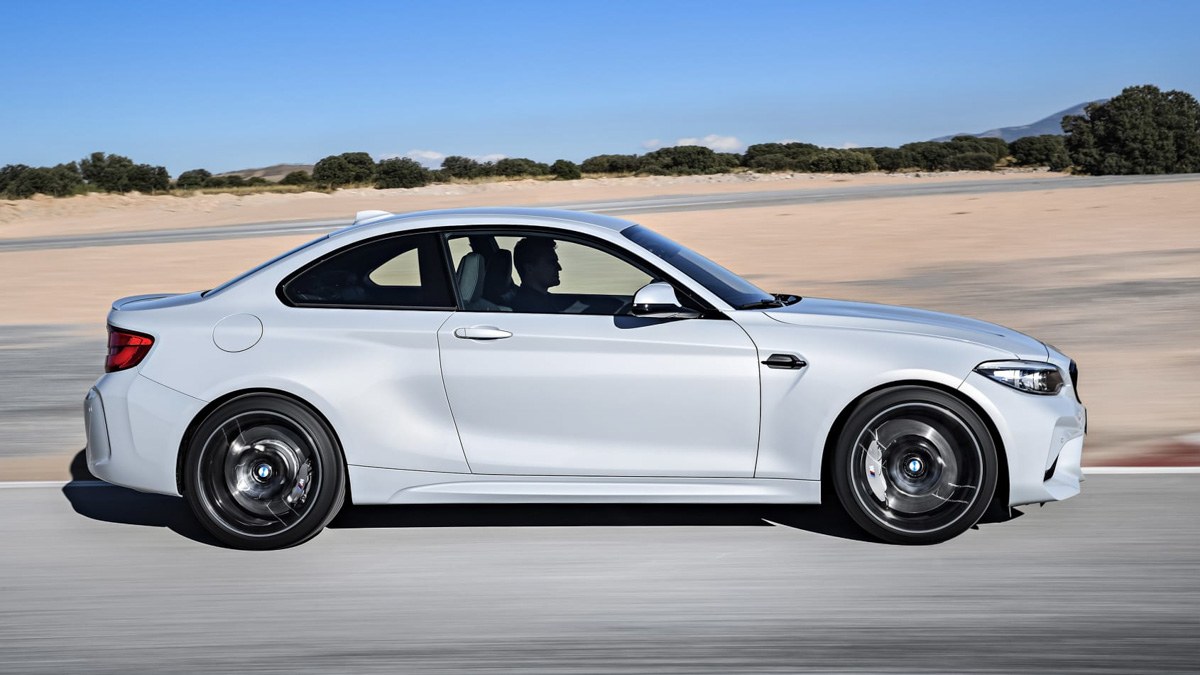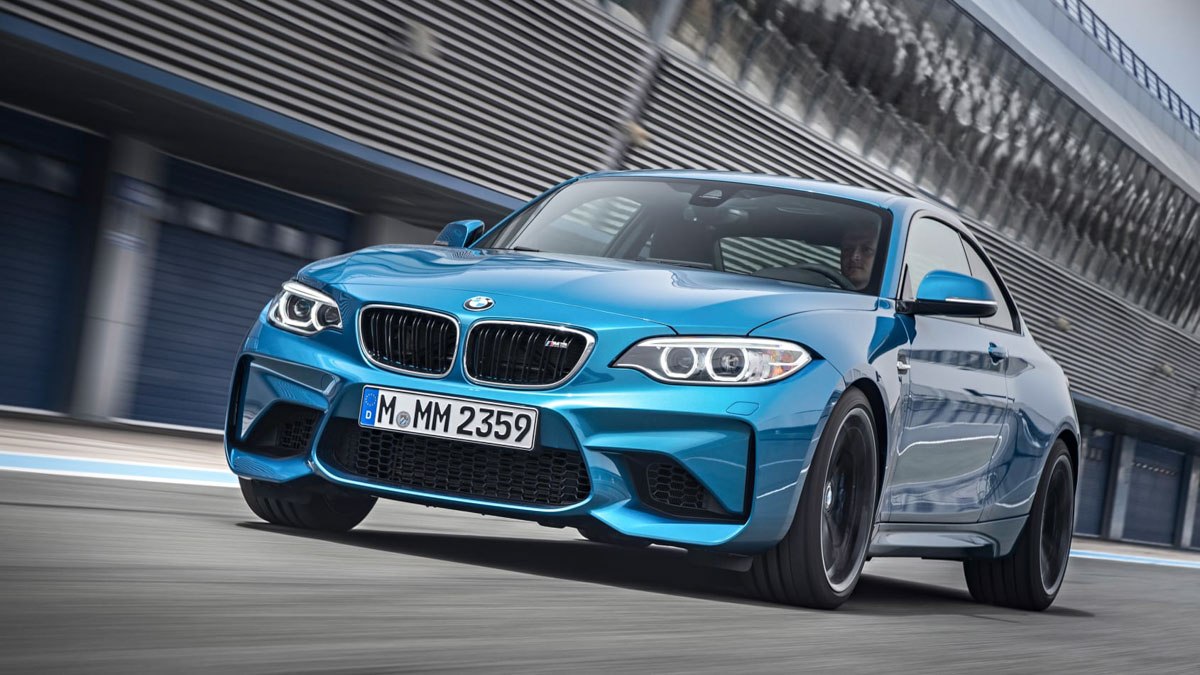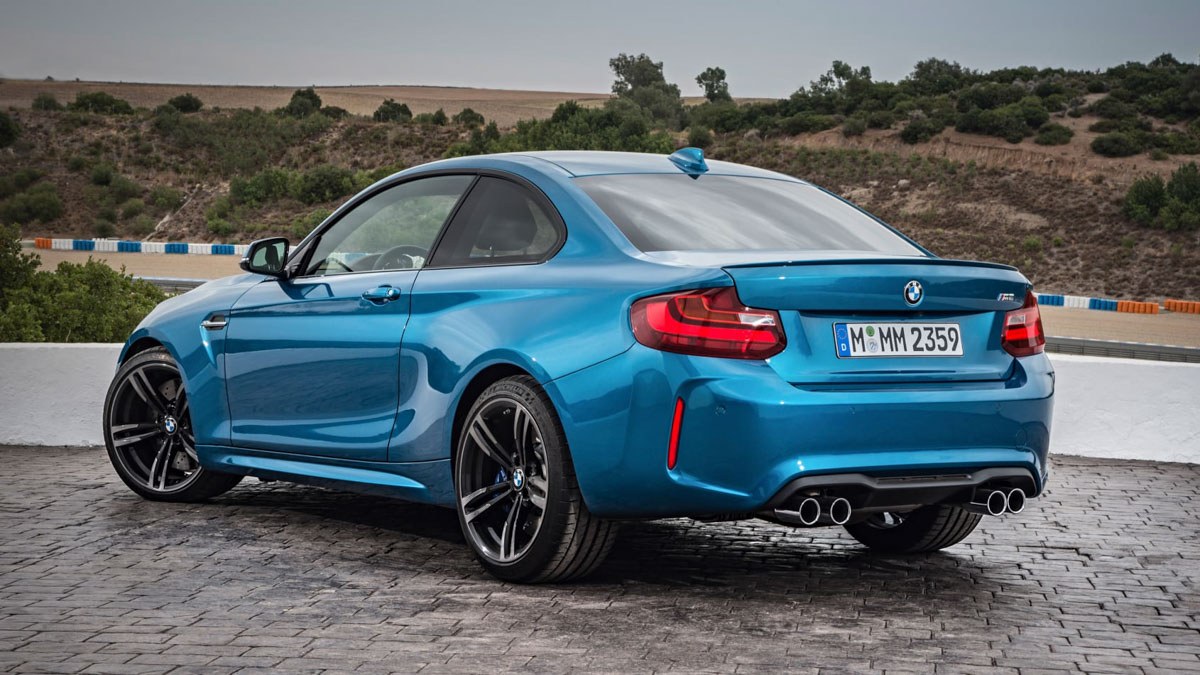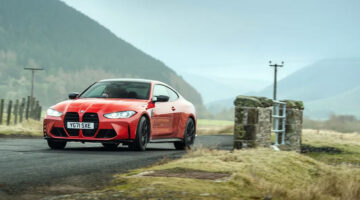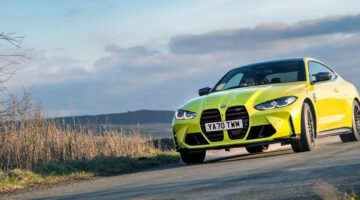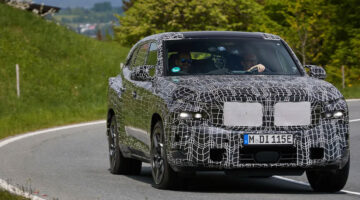The last of its generation, the M2 is a throwback to a golden age of small, rear-wheel-drive performance models from Munich
| Controllable, well balanced chassis, cracking engine | |
| Ride can still get agitated, standard brakes suffer on track |
PRICE from $70,621
The BMW M2, a last bastion of BMW’s illustrious history of building two-door saloon cars powered by a six-cylinder engine powering the rear wheels via a six-speed manual transmission. Where once that combination of elements was the norm for performance car enthusiasts, 2020 is a different era – except for the BMW M2.
The small two-door saloon (although plenty will prefer it to be called a coupe) has been on sale since 2014, and in pre-Competition form its lukewarm reception was pinned on its somewhat wayward handling and uninspiring non-M Motorsport engine.
That all changed in 2018 though, when the Competition arrived with the proper S55 engine, revised suspension, and a host of other detail changes that aimed to finally make the M2 a real successor to not just the excellent BMW 1 M Coupe, but its historical predecessor the E30 M3.
Despite its relative age, the M2 should only get better in 2020 too, with an even hotter $99,460 M2 CS due to close this generation of compact BMW with an almighty bang later in the year.
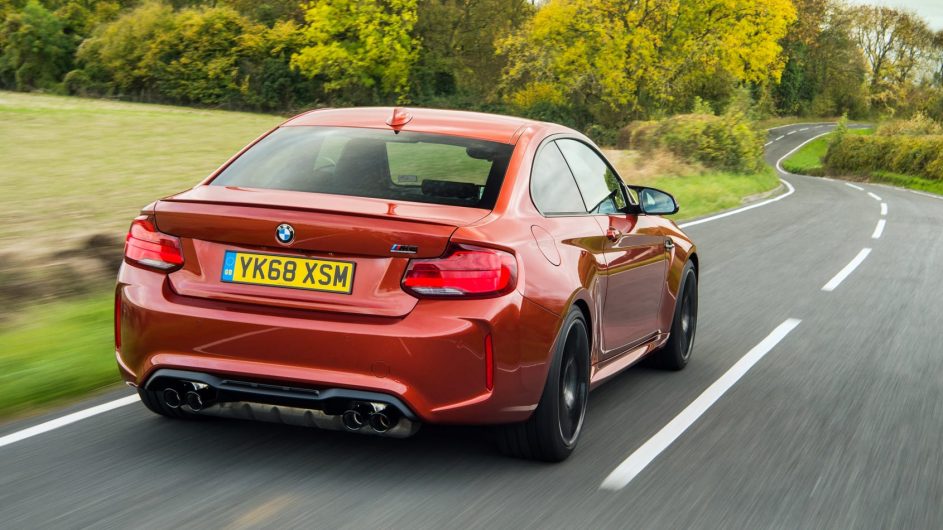
Prices, spec and rivals
Should you refrain from ticking any options, you needn’t worry about the M2 Competition feeling sparse, as it comes with plenty of kit as standard. Only five no-cost paint options make it somewhat limited in the colour department, but the marque’s ‘individual’ programme will likely encompass the M2 at some stage to give you free rein.
We much prefer the manual ‘box, too, so you wouldn’t have to splash out on the $3490 DCT alternative to have the best experience. Although not carbon ceramic, an additional $1780 will get you BMW’s M Performance brake package, increasing disc size to a respectable 400mm.
Rivals come in the form of the Audi TT RS, Alpine A110, Porsche Cayman and the Mercedes-AMG A45, although we feel the TT RS is the best match overall. Even so, the cars certainly have their differences. The TT RS is a four-wheel drive, two-door coupe, capable of putting all 394bhp to the tarmac in an impressively efficient manner. Perhaps a little too efficiently, though, as it’s less involving than the M2 for it. The TT RS is also a more expensive machine, starting at $69,325 as opposed to the BMW M2 Competition at $67,900.
Our recent triple test between the Alpine A110, Porsche 718 Cayman S and Audi TT RS put some of the M2’s biggest rivals head-to-head with the Cayman narrowly beating the Alpine. In terms of cost, the M2 Competition sits between the Porsche 718 Cayman and Cayman S, but is significantly more powerful than both as well as having rear seats. However, although the BMW’s six-cylinder engine is a paragon of aural pleasure compared to the 718’s cacophonous flat-four, the Porsche’s perfect mid-engine balance makes it the purer driving machine, if not the more exciting.
If that line-up is all too Teutonic for you, perhaps you could consider the Ford Mustang. It beats the M2 in terms of all-out power, and is almost $13,000 cheaper. However, the BMW is worlds ahead in terms of poise and driver engagement.
The M2 CS is an altogether more serious proposition, with forged wheels, carbonfibre styling additions and a bespoke carbon bonnet that’s vented like you’ll see on the M3 and M4 CS. Beneath the more aggressive skin is also the same 444bhp M4 Competition-spec engine, which is able to be matched to either a six-speed manual or seven-speed dual-clutch transmission. These extras don’t come cheap mind, with a $99,455 starting price for the CS. We’ll get to drive that model later this year – something we’re very much so looking forward to.
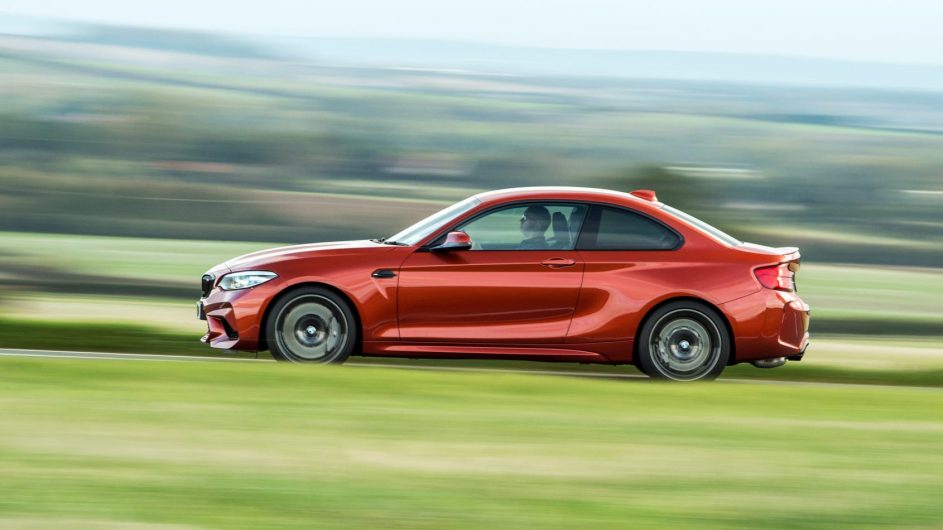
Prices for the M2’s predecessor, the 1M Coupe remain strong and are currently still over $53,000, irrespective of age or mileage. It may not quite have the same power or the same poise as the M2, but it’s similar in size, looks better and, as they were built in small numbers, more exclusive. If you’re looking for an M2, don’t discount a second-hand 1M Coupe as a real alternative.
There are a selection of M Performance upgrades you can make to your M2. Most of them are just cosmetic carbonfibre body additions and, as the M2 already looks aggressive enough, they seem pretty superfluous. However, a sportier exhaust, which can be turned on or off by a Bluetooth controller in the car, adds a bit of drama while a set of coilovers lower it without changing the car’s balance or behavior greatly. There’s also the possibility of an Alcantara steering wheel and interior trim; they might not be essential, they do look and feel great.
Engine and gearbox
Until recently the M2 made do with the engine from the old M235i, albeit with a smattering of M3 and M4 components as well as a few bespoke parts. In many ways it was the weak link in the M2’s otherwise impressive strong chain, denying the car true M car status. However, that’s all changed with the Competition, which gets the same S55 twin turbo charged unit as the M3 and M4.
To gain some extra power over the M235i, the old M2 had a larger intercooler and used the pistons and forged crankshaft from the M3/4. It also had a modified sump, to help cope with the higher g-forces on track.
At 365bhp it sat in the middle, in terms of power, between the M240i (the replacement for the M235i) with 335bhp and the M3/4 with 425bhp. The engine’s behavior slotted into the same hierarchy, too; it wasn’t as brutal as the M3 and M4’s ‘six and it didn’t chase round to the red line in such an aggressive and enthusiastic manner. However it was smoother, more linear and more predictable, while still being wilder than the conventional motor in the M240i.
There are two gearboxes available on the M2: a six-speed manual and a seven-speed dual-clutch transmission. The contrast between the two is marked, while the manual allows complete involvement and further access to the manageable handling, the DCT feels like a blunt instrument. In Sport and Sport Plus driving modes, the semi-auto hammers each gear home with such force the rear tyres can barely cope. At full throttle, as one clutch reengages the drivetrain the rear wheels jolt causing the car to wiggle from the back. The extra ratio seems unnecessary too; the torquey six-cylinder is more than capable with just six gears.
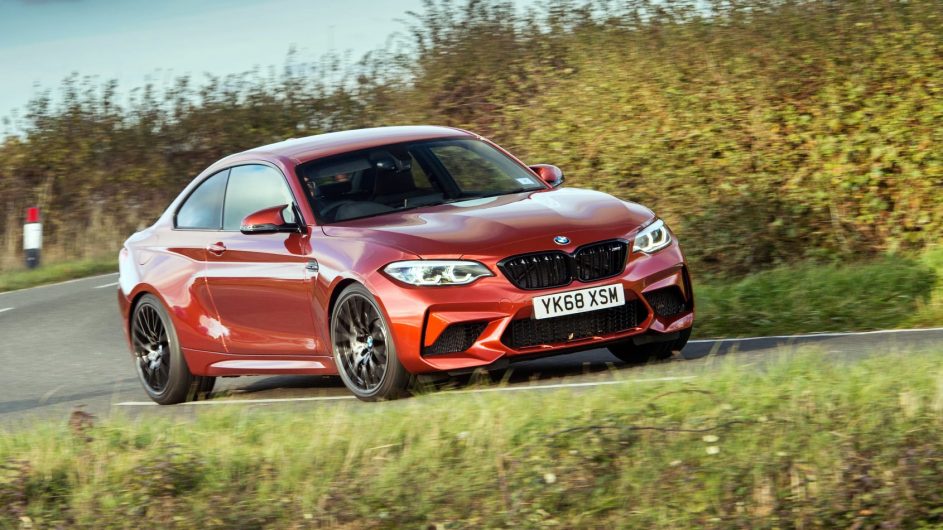
Performance and 0-100kph time
The DCT (dual-clutch transmission) equipped M2 officially dashes from 0-100kph in just 4.2sec, putting it 0.2sec faster in a straight line than the manual car. Traction feels strong and the new engine gives every impression of being able to get close to the claims, in the dry at least.
With 404bhp (up from 365bhp) the M2 Competition is certainly quick enough. Its twin turbocharged, 2979cc, in-line six cylinder engine puts out 406lb ft from as little 2350rpm, giving it a elastic flexibility in all gears.
Top speed, as you’d expect, is limited to 250kph. However, if that’s a little tame for you and you plan on spending lots of time on the autobahn, then the $2765 M Driver’s Pack raises top speed to 280kph. It also gives you access to one of BMW’s advanced driver training courses.
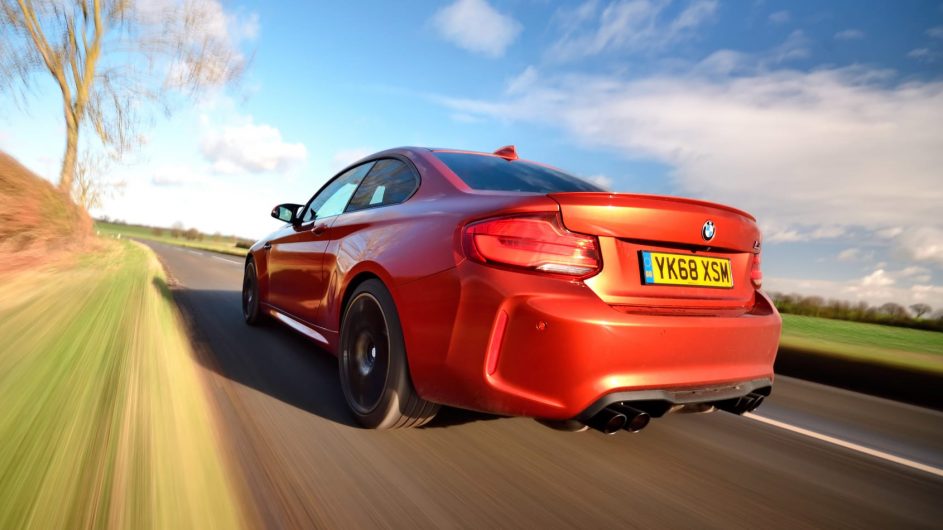
Ride and handling
The 2-series has been totally reworked to create the M2; compared to an M235i, it’s 8mm lower, the front track is 58mm wider, the rear is 45mm wider and wheelbase is 3mm longer. The M3/4’s front and rear aluminium suspension is carried over to the M2 too, and the rear axle remains solidly mounted just as on the bigger M car. On top of this little lot the Competition adds strut and bulkhead braces from the M4, plus stiffer ball joints in place of the old rubber bushes in the rear axle.
The M2’s ride is firm, without switchable dampers (none of the driving modes change the dampers, and they can’t be adjusted individually either) it stays firm all the time. On rough local roads, there are times you wish for a little more compliancy, but the upside is that the old car’s slightly wayward rear axle feels more tied down and precise now. It’s only on the worst roads that the M2 can start get a little frisky, the short wheelbase causing the car to pitch around a little.
Strengthening the bodywork has delivered improvements, with the M2 now having a similarly direct and grippy front axle as the M4. In combination with the recalibrated ESP and MDM electronically controlled rear differential it endows the Competition with a nimbleness that its bigger brother can’t match, the M2 swivelling around your hips in time with inputs to the steering.
As a result the M2 is imbued with a flow that is most impressive, allowing you to easily and confidently generate a rhythm when driving quickly. The chassis, grip, engine, diff and steering all add up to create such an intuitive driving experience.
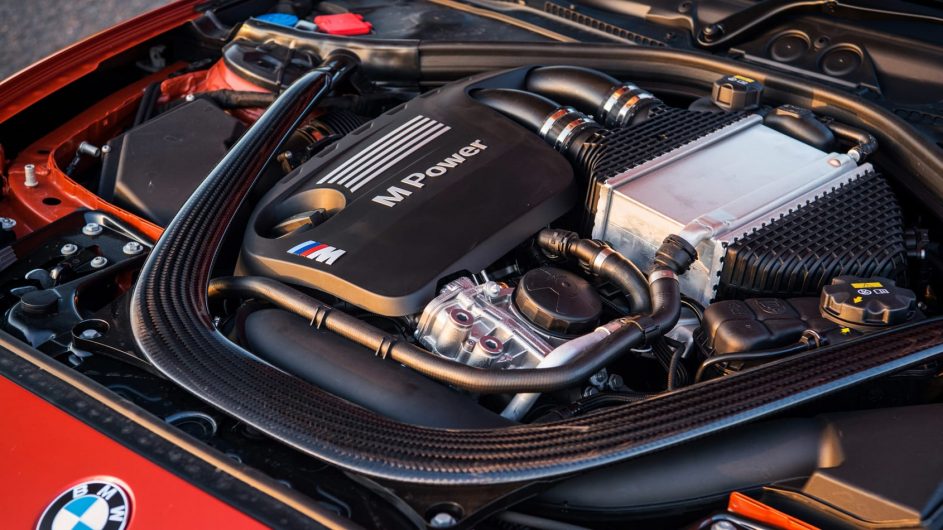
If you judge your speed well and brake late into a corner, you can start to feel the car want to rotate simply on turn-in. It doesn’t break traction, or even transition into oversteer, but you get a sense of how nimble the M2 is.
Once you’ve experienced that slight rotation you can get on the throttle and use the acceleration to help you round the rest of the corner, the throttle directly influencing your line. The engine’s vast amounts of torque mean that the rear tyres, that already seem to be close to their limits, are easily overwhelmed.
Once the rear wheels have started to spin, the engine’s response and linear delivery means the rear is easy to control. You can regain grip with a small lift, maintain a nice neat slide around the corner with a fairly constant throttle, or add more throttle for a bigger slide.
There’s a minimal amount of roll, especially at the rear. This lack of body roll adds to your confidence in the M2, you never have to wait for the body to respond it’s instantly there with you. It also means that weight transfer is small, and so recovering from a slide is neat and satisfying.
Thanks to such a transparent chassis, you can keep the M2 near its limits corner after corner. There’s not a lot of feedback from the steering, but that’s not a problem as you can easily judge the car’s limits from the clear information transmitted through the suspension.
The M2 is shod with set of bespoke Michelin Pilot Super Sports, a lot of how controllable the car is, can be attributed to these tyres and how well the chassis and drivetrain has been developed to work with them. The way the rear remains controllable and adjustable, even once the tyres have broken traction, just adds to your confidence in the M2 even more.
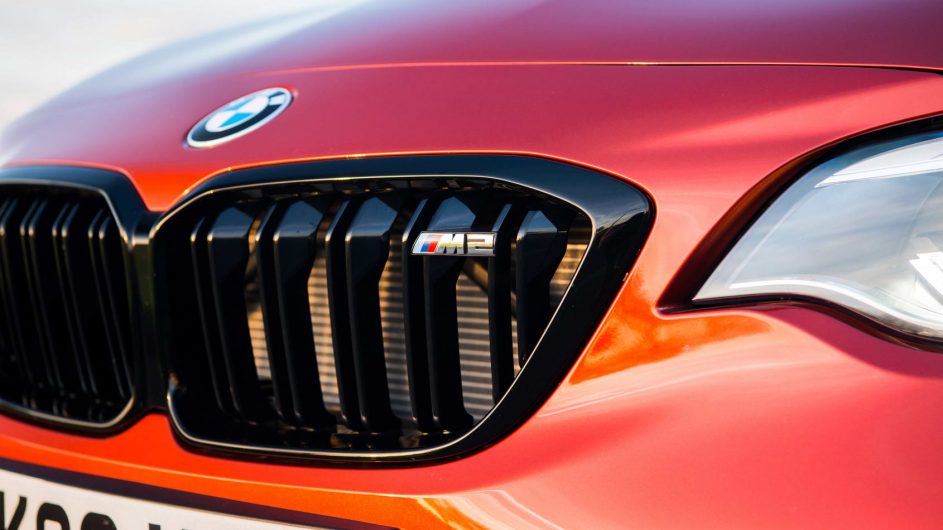
In the wet, the M2 still doesn’t behave like a scary, wild, turbocharged, rear-wheel drive car that you might expect it to. Its limits are lower and some understeer is more detectable, but it’s not particularly pronounced and is easily quelled with a good jab of the throttle.
On the manual car, the throttle automatically blips for every down-change. It’s very competent, and matches the revs perfectly without fault. However, if you’ve spent your driving career trying to perfect the art of the heel-and-toe, you’ll still want to do it yourself. The only way to turn off this function is to turn off all of the traction aids.
If you’re used to the M3 or M4, turning off the traction control completely is a daunting prospect; you need to be brave and alert. It’s different in the M2 though, because despite the short wheelbase, the handling is more predictable and the engine offers much more control.
In fact, with the traction control left on (even in its more relaxed MDM state) it feels less of a safety net and more of a frustration. If you choose to reach an angle of slide that is just a touch too great, the computer kills all the fun immediately. If you do prefer the added security of some traction control, and you don’t attempt too large a slide, the MDM still allows for some fun – even if you do have to make do with the auto blip downshifts.
There is no carbon ceramic brake option for the M2, and on the road that is perfectly fine as the cast iron units never seem to get too hot. On track it’s a different story, with the stoppers starting to groan and grumble in complaint after several hot laps, although the stopping power itself remains fairly strong.
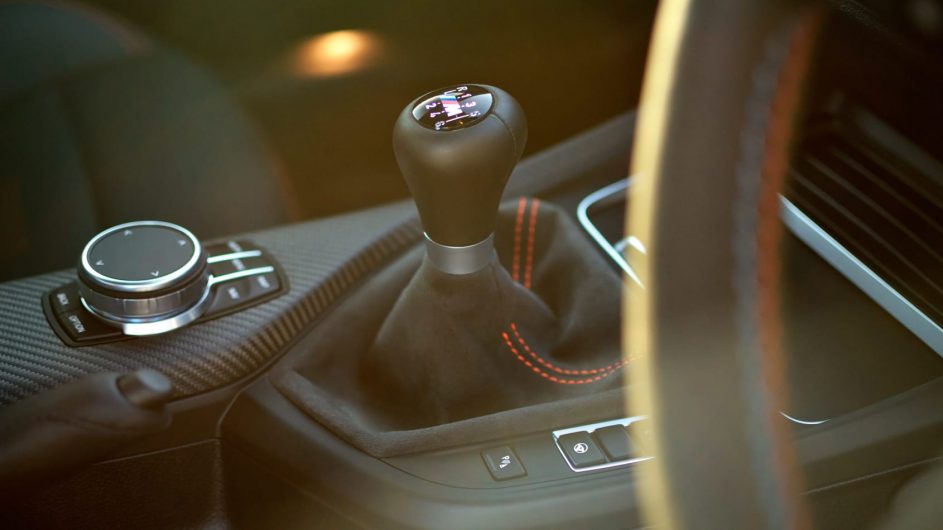
That is until you misjudge your speed, even by a fraction. To scrub off enough speed you then have to press the brake pedal beyond the sensitive top fraction and the car doesn’t continue to decelerate at the same pace. All that’s required to rectify this is a harder press of the pedal, and you do so. But, the moment where the brakes aren’t with you, although brief, is just long enough to make your heart skip a beat.
On track the M2 is feisty, wanting to oversteer almost everywhere. Stringing together a neat lap isn’t easy, but it is fun and demanding trying to do so.
If you feel tempted to modify your M2 there are plenty of options, one of which includes BMW’s own in-house M Performance range of parts. They don’t add any extra power or torque, but a set of height adjustable coilovers allows you to change the height and stance of the car. Amazingly, the new springs and dampers barely change the car’s behavior.
Renowned BMW tuner, AC Schnitzer, offers more power as well as chassis upgrades, but the results aren’t dramatic. It’s certainly not as intense as AC Schnitzer’s wild ACL2, a thoroughly modified M235i with the twin-turbo engine from the M4 with 503bhp.
The M2 has the poise that a great BMW M car should have. It might not possess the same sort of aggression as its bigger siblings, but because of that it’s more wieldy, more controllable, more predictable and, ultimately, even more fun car to drive quickly.
L/100km and running costs
Despite being the baby M car, the M2 Competition is hardly what you’d call frugal. While the adoption of the M4’s engine has done wonders for the performance and sound track, its drilled a figurative hole in the fuel tank, with the DCT equipped car managing a claimed 9.2L/100km, compared to 35.8mg for the old car. The six-speed manual achieves 10L/100km.
Like the A45 AMG and Audi RS3, the M2 is designed to give younger buyers, or those who wouldn’t usually consider a full blown M-car, an entry point into the market. As such the running costs of an M2 won’t considerably exceed that of an M240i, but expect to replace the chunky rear tyres relatively frequently if driven with ‘intent’.
If the M2’s predecessor, the 1M Coupe, is anything to go by it’s likely to hold it value well. The 1-series M-car has been growing in value over the last few years due to its cult following and limited build numbers. The M2 won’t be as exclusive, but second-hand cars haven’t dropped much below the asking price of a new car.
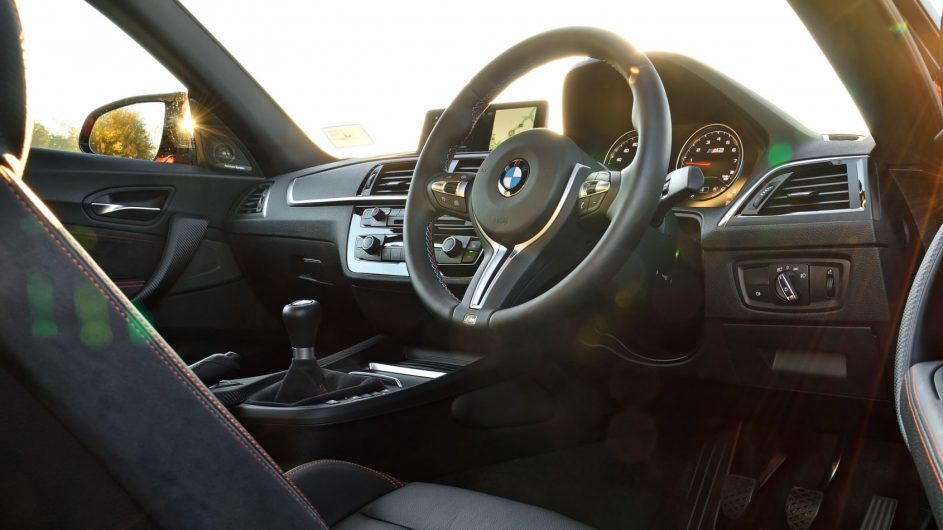
Interior and tech
If you’re familiar with the BMW 2-series Coupe’s insides, you’ll be familiar with the M2’s as well because not a lot is different within the cabin. That’s not, in itself, a bad thing, as the interior of the 2-series is an all right place; it’s functional, well put together with nice materials but not the last word in luxury or sportiness.
To make it feel slightly more special, there’s M tricolour stitching on the steering wheel, while the high-backed sports seats (complete with illuminated M2 badge in the backrest) are now standard. As is de rigueur for a performance car, there is carbonfibre trim inside; the M2 has ‘raw’ carbonfibre, not set in any resin, around the door pulls and centre console. It’s a nice departure from the usual, shiny carbon and looks pleasantly understated.
If you opt for the DCT ’box then, rather than the tall shifter used in ordinary BMW’s equipped with automatic transmissions, you get the short, teardrop-like M stick. It is smaller and neater, but makes it awkward to engage park – it isn’t a mere press of a button marked P, you need to turn the car off while it’s still in gear rather than neutral.
Design
The BMW M2 covers its wider track with bloated arches, like rounded box arches that swell gradually down the sides and it looks very much like a junior version of the M4. It’s a butch, purposeful looking machine, but doesn’t quite have the stance or drama of the older 1M Coupe, that had abruptly flared arches.
In the presence of an M240i, the M2 looks stocky and incredibly aggressive. The changes made over the standard car make it difficult to believe they’re even related.
With the wide arches and all the cues of a modern M car; the quad tail pipes, diamond cut alloys and deep front bumper – it looks suitably pugnacious.
This article originally appeared at evo.co.uk
Copyright © evo UK, Dennis Publishing

